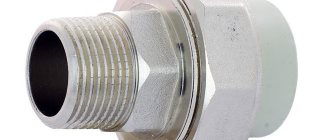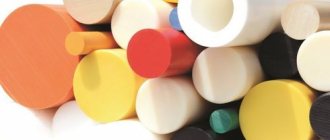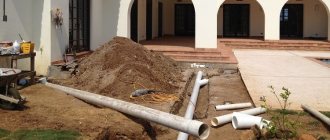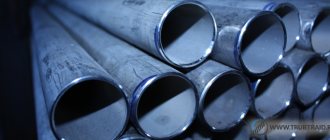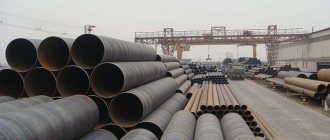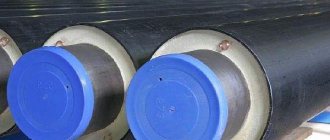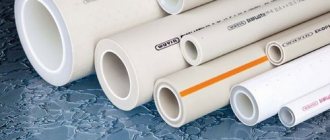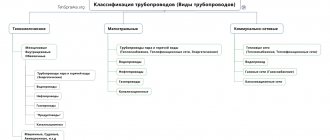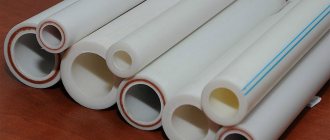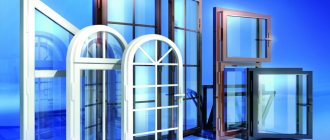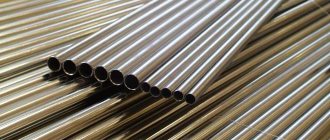Pipes are a structural element that is used in the installation of pipelines of various directions. Today there are many varieties of these products. There are outdated, but still popular parts and modern options from which reliable and durable communications are installed.
Modern industry offers a large number of types of pipes for a variety of types of work.
What types of pipes are there?
All pipeline pipes are classified according to several important parameters. Let's consider the main ones:
First of all, the following types of pipes are distinguished by diameter:
- small;
- average;
- big.
A small-sized part has a cross-sectional index from 5 to 102 mm, medium – from 102 to 426 mm, and products that are classified as large – above 426 mm.
Note! Another important factor by which all pipes are divided is throughput. The throughput directly depends on the diameter of the product and the characteristics of the internal walls, as well as on the number of bends in the pipeline.
In addition, they are classified according to the following indicators:
- according to the material of manufacture;
- along the cross-sectional profile;
- by size;
- by connection method;
- by type of insulation.
Some types of pipes are equipped with insulation; such products are used in the installation of heating networks and hot water mains.
Polyethylene pipes
These pipes are intended for internal and external pressure pipelines (drains, water supply and sewerage). They are divided into two types: “T” and “C”, their operating pressure depends on this: 10 and 6 atmospheres, respectively. The connection method depends on the diameter of the pipe: 20-63 mm - using a fitting or electric welding couplings, 63-160 mm - butt welding.
They are divided into high-pressure (LDPE) and low-pressure (LDPE) pipes. For sewerage, free-pressure pipes are used, which are also divided into HDPE and LDPE.
The advantages of these pipes are as follows:
- High tightness of connections;
- It is possible to carry out installation work at a temperature of – 200;
- Resistance to corrosion, overgrowth, chemical compounds, biological organisms;
- High level of wear resistance;
- Service life of at least 50 years.
Disadvantages include low heat resistance (+40), instability to active substances and UV rays.
Steel pipes
Steel products are considered an outdated option for installing plumbing and other systems. But, nevertheless, they are still in certain demand. They themselves are not resistant to corrosion and therefore require a protective coating. As a rule, the protective layer is made of zinc - such products are called galvanized.
First of all, such pipes are divided into:
- suture;
- seamless.
And after that, according to the specifics of production, on:
- galvanized;
- welded;
- hot rolled;
- cold rolled;
- profile;
- cold drawn.
Installation of steel products, due to their weight, is quite complicated, but they are still used in various pipeline structures - technological and utility.
Seamless steel pipes are one of the most durable pipe products
According to the type of section, the following types of steel pipes are distinguished:
- round;
- square;
- rectangular;
- polygonal.
Such products are connected to each other: with special couplings, threads or welding. They are very durable and can withstand high pressure levels.
The dimensions and weight of steel pipes are presented in Table No. 1.
Table 1
| Du, mm | Outer diameter, mm | Weight of 1 m of pipe, kg |
| 125 | 165 | 15,04 |
| 100 | 114 | 12,15 |
| 50 | 60 | 4,88 |
| 40 | 48 | 3,84 |
| 32 | 42,3 | 3,09 |
| 20 | 26,8 | – |
| 10 | 17 | 0,8 |
During operation, the characteristics of steel pipes deteriorate - they inevitably lose their throughput due to narrowing of the lumen. In addition, they conduct electricity, which can result in electric shock if the wiring is faulty. The service life of steel products is approximately 25 years.
Metal pipes
The most common type of pipes for water supply and water heating systems today are steel pipes. Depending on the production method, they can be welded or seamless (seamless). The latter are somewhat more expensive, but more reliable.
Steel pipes can be either with or without an anti-corrosion coating inside and/or outside; such pipes are also called black. An electrolytically sprayed layer of zinc is usually used as a coating. Galvanized pipes do not require additional priming, painting or similar measures to protect against rust, with the exception of areas with cut threads - the thin protective layer on them is broken. When connecting galvanized pipes with steel (not cast iron) fittings, you should take this fact into account and take care of reliable anti-corrosion protection; a rusted steel coupling firmly “seizes” with the threads of a galvanized pipe no worse than with a “black” one.
The outer diameter of steel water pipes can vary significantly depending on the wall thickness. Therefore, when talking about the diameters of steel pipes, they usually mean not the external, but the internal - the so-called nominal diameter, or the “clear” diameter. Its value is more constant than the diameter of the pipe itself. The nominal diameter is measured in millimeters.
At the same time, you have probably heard how pipes are characterized by a different unit of measurement. When they say “three-quarters of an inch” or “one-second of an inch” about a pipe, it seems that we are also talking about the diameter. How do you figure out all these fractions?
Very simple. In the second case, we are indeed also talking about diameter. But not about the internal, but about the external, depending on the diameter of the thread that can be cut on a particular pipe.
The reason for this “double standard” lies, literally, on the surface. Since the outer diameter of the pipe is, as already mentioned, a very approximate thing, a more reliable characteristic was chosen, because the size of a particular thread is a standard value. And since pipe threads are measured in inches (as is customary), they say for brevity and greater accuracy: “one-second of an inch” instead of “about twenty and a half millimeters.”
In apartment wiring, half-inch and three-quarter pipes are used. Their internal diameter is 15 mm and 20 mm, respectively, and the external diameter can be from 20.4 to 20.7 mm for the former and from 25.9 to 26.2 mm for the latter. For convenience, it should be assumed that any pipe on which one or another thread can be cut is named in accordance with the diameter of this thread.
Thus, an inch pipe would be approximately 32.9 mm in diameter, a seven-eighths (inch) pipe would be approximately 30 mm, three-quarter pipes would have an outer diameter of approximately 26.8 mm, and a five-eighths (inch) threaded pipe would be approximately 22.5, and a half-inch pipe is a pipe with an outer diameter close to 21.5 mm.
Galvanized and non-galvanized steel pipes on sale come in different lengths. They may or may not be threaded on one or both ends. Often, the manufacturer also supplies the retail chain with sets of connecting parts—fittings—along with the pipes.
Galvanized steel
Galvanized steel parts are more reliable, but this is reflected in their cost. They are resistant to temperature changes and, thanks to the protective zinc layer, are resistant to corrosive influences. However, the protective layer may be damaged for one reason or another (from impacts) and then rust will appear in the places where it has broken off.
Pipes with a protective zinc coating are not afraid of corrosion, so they last longer than usual
Such pipes are used in cases where it is necessary to install a durable structure that will not be subject to pressure changes and temperature changes. Galvanized steel parts are ideal for temporary structures in harsh operating conditions.
Assortment of seamless steel pipes, according to GOST 8732-78 91
The production of hot-deformed seamless steel pipes in accordance with GOST 8732-78 (91) is characterized by the presence of lengthy and complex processes. This factor explains the rather high price of these products. The use of hot-deformed and cold-rolled seamless pipes is suitable for extreme conditions, where in the event of the slightest leak the consequences can be very serious.
The raw material for the production of hot-deformed pipes without seams are metal blanks: the piercing process and heating to high temperatures leads to the formation of hollow cylinders - sleeves. At first, their irregular shape becomes smooth due to the passage of the rollers. Segments 4-12.5 m long are cut from the sleeve (the length can be measured or unmeasured).
For hot-rolled steel, according to GOST, a slight discrepancy in wall thickness is allowed. The same applies to deviations in diameter: the main thing is that these differences do not exceed special regulatory instructions. The list of permissible diameter deviations in accordance with GOST 8732-78 (91) is available in special documents.
Copper pipes
Copper water lines are the most expensive option of all. They are distinguished by high technical characteristics: durable, resistant to corrosion and temperature changes (operating temperature indicators range from –200 °C to +250 °C). In addition, due to their appearance, they can become an interior decoration. However, the modern market can offer parts that meet the required technical characteristics and are cheaper, so such pipelines are installed solely because of their aesthetic “exterior”. The service life of copper alloy products can reach 50–100 years.
Important! When installing a copper pipeline, it is worth considering that copper is incompatible with connecting elements made of other metals. Therefore, fittings for copper structures must be made of the same material.
The dependence of the wall thickness of copper pipes on the diameter can be found out by studying Table No. 2.
table 2
| Du, mm | Wall thickness, mm |
| 10–28 | 1 |
| 35–54 | 1,5 |
| 54–89 | 2 |
| 89–108 | 2,5 |
| 108 | 3 |
Components for such products are quite rare and sometimes difficult to find on sale (especially for non-standard designs). Installing copper piping is an expensive and difficult task.
Copper pipes are very popular due to their strength and long service life
It is also worth noting that the strength of such communications leaves much to be desired. The copper part can be easily dented, thereby narrowing its clearance. Therefore, the operation of such pipelines must take place without the risk of damaging them mechanically.
Precision steel pipes according to GOST 9567-75
This group of products is controlled by a separate GOST, since their production requires compliance with increased precision and special measures.
These types of metal pipes are classified depending on the wall thickness and production method:
- With especially thin walls . The diameter here has a ratio with the wall thickness of above 40, with a thickness of less than 0.5 mm.
- With thin walls . For the first indicator, the level is set at 40 and below, with a wall thickness of less than 1.5 mm.
- With thick walls . The first ratio is from 6 to 12.5.
- Particularly thick walls . The ratio is less than 6.
All precision pipes are seamless and have high isotropic rigidity. This makes it possible to organize various systems of increased accuracy and complexity even from thin-walled steel products in accordance with GOST 9567-75. The surface of such a pipe can be galvanized or phosphorated, coated with oil.
Cast iron pipes
Cast iron pipelines are resistant to corrosion, however, they are not as durable as steel ones. Among other disadvantages, they are heavy and require reliable fastenings for their installation.
Plumbing structures, as well as heating and sewer lines are assembled from cast iron parts. Today, there are three types of cast iron pipes, differing from each other in terms of strength:
- black cast iron;
- gray cast iron (more durable);
- products made of high-strength nodular cast iron (ductile iron).
Parts cast from gray cast iron have good strength and have rough walls. Ductile iron pipes are highly durable and can withstand heavy loads in the soil or under the road surface. The diameter of cast iron products varies from 50 to 1000 mm. The service life of such pipes is 20–50 years.
There are the following types of cast iron pipes according to the connection method:
- bell-shaped;
- products joined using caulking.
Cast iron pipes are strong, but fragile, so they require caution when working with them
Sometimes, to improve anti-corrosion characteristics, cast iron pipelines are coated with a protective coating of varnish or bitumen.
Seamless pipes
A distinctive feature of seamless pipes is the integrity of their structure. They are divided into cold and hot deformed. Cold-formed ones are produced on the basis of GOSTs 8734-75 and 8733-74.
They can have an outer diameter and wall thickness of 5-250 mm and 0.3-24 mm, respectively. Such products are distinguished by precise geometric dimensions and high surface cleanliness. They are most often used in the refrigeration industry, automobile and aircraft manufacturing, as well as in pipeline laying.
Hot-deformed pipes are produced on the basis of GOSTs 8732-78 and 8731-74. Their outer diameter and wall thickness can vary between 28-530 mm and 2.5-75 mm, respectively.
Such products have higher rigidity compared to cold-formed ones and bend poorly. Externally, hot-deformed pipes have a rough surface. Most often they are used in mechanical engineering, oil production and chemical industries, as well as for the construction of pipelines with high design pressure.
Seamless pipes are characterized by the absence of any joints
Metal-plastic pipes
Products that are produced as a combination of metal and plastic are very popular and have excellent quality characteristics. Installation of a pipeline made of metal-plastic pipes is perhaps one of the simplest. Anyone can assemble such a structure with their own hands if they carefully study the rules and installation tips, and also purchase all the necessary materials and tools.
The negative qualities of these pipes include the possibility of leakage at the joints and poor thermal stability. In addition, metal-plastic communications are not fire-resistant.
Note! The metal-plastic product consists of layers, which during operation under temperature changes can delaminate and form a gap between the connecting part and the pipe.
The operating temperature for metal-plastic parts is 80–100 °C. Various pipelines are made from such pipes: hot and cold water pipes, heating pipes, communications for heated floors. They are resistant to aggressive chemicals and have anti-corrosion properties, and the metal layer increases the strength of the structure. The service life of such products is approximately 30–35 years.
The connection of such pipes is usually carried out using special fittings. All fittings are divided into:
- threaded;
- press fittings.
Metal-plastic products are applicable for many types of systems - heating, plumbing, gas
Today, press fittings are considered popular connecting elements for metal-plastic communications, with which you can mount a strong and reliable connection.
Cross-linked polyethylene pipes
Cross-linked polyethylene pipes are made from polyolefin thermoplastic. This type of pipe is used for pressure hot and cold water supply and for heating. The range of diameters is not large, from 12 to 32 mm.
Cross-linked polyethylene pipes are installed using press fittings. The main advantages of these pipes include: high temperature resistance (up to 900), increased resistance to physical stress and pressure, resistance to UV rays and aggressive chemical environments.
The main disadvantage is the high linear expansion (when heated, the pipes lengthen), which does not allow the use of these pipes when laying open water pipelines. Most often used for heated water floors.
Most of the above products are considered as types of water pipes and only one of them can be used for gutters. We want to talk about them below.
Plastic pipes
Plastic is a general name for pipes made from various polymers. Each type of such products has its own characteristics and properties.
Polyethylene. There are the following types of polyethylene pipes:
- low pressure polyethylene (HDPE);
- high pressure polyethylene (HDPE);
- cross-linked polyethylene.
Polyethylene parts do not withstand high temperatures (except for cross-linked polyethylene parts), so they are most often used for the installation of cold water supply structures or sewer lines.
The positive characteristics of products made from this material include:
- ease of installation;
- anti-corrosion;
- a light weight;
- long service life (up to 50 years).
The diameter of polyethylene pipes ranges from 10 to 1000 mm. They are able to withstand pressure from 2.5 to 16 atmospheres, and in some cases even more. The operating temperature can be from –40 to +40 °C.
Such pipes are connected using welding or electrofusion. The latter is equipped with a special wire that heats the joint and forms a strong adhesion.
Communications made of polyethylene are laid both above ground and underground
PVC. A common type of pipe that is used in the following areas: sewerage, water supply systems, drainage systems. The diameter of such products can be from 16 to 500 mm, and the operating temperature reaches +90 °C. For hot water supply systems, parts with a cross section from 16 to 50 mm are used.
The pressure that polyvinyl chloride pipes can endure during operation ranges from 6 to 46 atmospheres. In addition, polyvinyl chloride is fire resistant, so it is often used to protect electrical cables and wires.
Simplicity of installation allows you to install polyvinyl chloride products quickly, without the use of any professional equipment. PVC parts are connected to each other using special fittings. The service life in some cases reaches 50 years.
Polypropylene. The most common type of plastic pipes and in general at present is the most popular type of all pipes for plumbing systems. Their popularity is due to many positive characteristics, but above all, ease of installation. These pipes are used in:
- hot and cold water systems;
- heating systems;
- when laying heated floors;
- in sewer lines.
The diameter range of polypropylene pipes can be from 16 to 125 mm. The PP pipeline is assembled using welding. For each category of pipelines there is its own type of pipes (PN10, PN16, PN20, PN25). The digital indicator indicates what pressure a particular product is designed for. That is, the marking of PN20 pipes tells us that such products are designed for systems with an operating pressure of 20 atmospheres.
Products made of polypropylene are conventional and reinforced with metal or fiberglass
Important! As a rule, pipe designations are applied to the outer surface of the product (no closer than 2 cm from the edge). Pipes marked PN10 are used for systems in which the working medium is cold water. Products marked PN20 are used for communications with cold and hot water, and PN25 for heating and hot water pipes.
Installation of polypropylene pipes is carried out by butt or sleeve welding using a low-temperature soldering iron. The service life of polypropylene parts when used correctly is 50 years.
Overview of the main types
I strongly advise you to carefully study all the information in this section and use it as a guide when purchasing pipes, and there is one good reason for this.
In my practice, I have repeatedly encountered the fact that salespeople in retail establishments give biased recommendations, trying to sell an option that is profitable for them, or even due to their incompetence. And if no consultant can deceive a knowledgeable person, then ordinary developers often fall for this trick and purchase what they were advised in the store.
Option No. 1 - steel pipes
Metal water pipes a couple of decades ago were practically the only option that was used in our country, but these days their popularity has greatly decreased and, after reading this section, you will understand why.
Let's start with the advantages of the product:
- The metal is very durable , so it is almost impossible to accidentally damage such communications;
- Previously, the main advantage of this option was the price, but today it cannot be called low. I will discuss this aspect in more detail below;
- A wide range of diameters and sizes, as well as a wide selection of various shut-off valves.
Steel is a material whose strength is known to everyone
But if we touch on the shortcomings, then their number is clearly greater:
- The material is susceptible to corrosion, and the outer part requires periodic painting . The problem is aggravated by the fact that condensation forms on the surface during temperature changes (which is constantly observed on a cold water supply);
Condensation is a permanent attribute of a metal pipe
- Steel has high electrical conductivity, which creates an increased risk of electric shock in the event of emergency situations and a short circuit in the system;
- If the system contains copper or aluminum elements, a chemical reaction is formed that causes a very violent corrosion process of the materials;
- Plaque inevitably forms on the inside of the system, and if it is not periodically washed , then over a dozen or two years the internal diameter can decrease significantly;
An example of what happens to a pipe if you don't flush it every few years
- Another very significant disadvantage of metal pipes is very labor-intensive installation. You will need either welding equipment (which I strongly advise against using without skills) or a thread cutting tool. The second solution at first glance seems simpler, but just think about how many connections you will have to make - it will take a lot of time and effort.
I would like to draw your attention to such a criterion as the diameters of water pipes, since people often ask me what size should be used to ensure good pressure even when all the taps in the house or apartment are turned on. Everything is very simple here: the optimal parameters are always specified in the project, which must be drawn up and approved before work begins.
It is made by specialists from your water supply organization and contains all the necessary data.
Difficulties for an ordinary developer may arise for the simple reason that the documentation indicates such an indicator as DN (nominal diameter), it denotes the average value in millimeters. In fact, you need to take into account the wall thickness in order to choose the best option for the outer diameter; for simplicity, below is a table of water pipe sizes, which will help you quickly find your way.
The outer thickness depends mainly on the thickness of the walls, again this also affects the weight of 1 m.p.
Now let's look at the price; it, of course, can vary depending on the supplier and region, but the average figures will allow you to navigate the current situation:
- A pipe of Du.15 with a wall thickness of 2.8 (the best option) will cost you from 65 to 75 rubles per linear meter;
- Option Du.20 with the same wall thickness will cost on average from 90 to 100 rubles per meter;
- The largest diameter used in the private sector is Du.25, the price of a meter ranges from 120 to 140 rubles per linear meter.
Option No. 2 - galvanized steel pipes
This solution is an improved type of steel pipe, which has the following advantages:
- The outer and inner surfaces are protected by a layer of zinc, which eliminates the occurrence of corrosion both outside and inside . I once dismantled a system that had been standing for about 10 years, and there was practically no plaque on the inside;
- The strength of the products is not inferior to ordinary steel, so they can be used wherever very high reliability and resistance to deformation are needed;
What if the surface is scratched, then corrosion will begin to form in this area. Therefore, you need to work with products quite carefully.
A galvanized pipe can be easily identified by its shiny surface
- There will be no problems with components; they are presented in a wide range in almost all retail outlets.
Now let's move on to the disadvantages, in my opinion the main disadvantages of this option are as follows:
- The rather high cost increases the cost of materials, and the difference is quite noticeable - from 30 to 40%;
- Few sellers keep such products in stock; you will have to order everything you need and wait for delivery from 2-3 days to 2-3 weeks;
- If the coating is damaged, then pockets of corrosion will subsequently appear in such areas;
- Metal conducts electricity very well, which can be dangerous in certain situations;
- The system is assembled exclusively by threading, which takes a lot of time and effort.
The advantage of galvanizing is that you don’t have to paint it, it looks great anyway
Another plus is that the mm dimensions are the same as regular steel options, so you can use the table above as a reference.
Now let’s figure out what the cost of a galvanized pipe is, let’s again consider three main options:
- A pipe of Du.15 will cost from 85 to 100 rubles per linear meter;
- Product DU.20 will cost from 120 to 140 rubles per 1 meter;
- The Du.25 option costs on average from 155 to 180 rubles.
Option No. 3 - corrugated stainless steel pipes
Stainless steel is a material with excellent performance properties
This option appeared relatively recently, but has already earned many positive reviews. From my own experience, I can say that working with this option is very convenient due to the following advantages:
- Stainless steel perfectly resists a variety of adverse influences, so the service life of such a water supply system is 50 years or more;
- Corrugated pipe is very convenient to use due to the fact that when laying it you can bend it the way you need , this allows you to quickly carry out the work even for those who do not have installation experience;
- The absence of connections at the corners makes the structure much more reliable. After all, your number of potential leak points is reduced to two - there are no joints between the individual elements, that is, you can fill the pipe with a screed, cover it with plaster and not worry about having to look for a connection later;
- The wall thickness is 1-2 mm, which makes the products lightweight, while their strength is very, very high;
- Brass fittings are used for connections - reliable and inexpensive, with their help the assembly process becomes simple and straightforward, because you do not need welding or a soldering iron.
Corrugated pipe is connected with brass fittings
As for the disadvantages, I personally don’t see any particular disadvantages, except perhaps the high cost. But if quality and durability are important to you, then you need to understand that you need to pay for it and pay a lot.
As for prices, at the moment, focus on the following figures:
- A pipe Du.15 will cost you from 155 to 180 rubles per linear meter;
- DN.20 will cost significantly more; per meter you will have to pay from 265 to 315 rubles;
- Finally, the Du.25 option has a price tag of 330 to 380 rubles per linear meter.
You can also use a regular stainless steel pipe, but its use is associated with both installation complexity and high costs; it costs an order of magnitude more than the corrugated version.
Option No. 4 - copper pipe
I couldn’t help but touch on this option, since it is also used in houses and apartments. First of all, I would like to note the fact that such communications are often used in America and Europe, but in our country they are chosen by those who want to make their home original. But it should be noted that this solution has many advantages, in my opinion the following advantages can be considered the most important:
| Resistance to deposit formation | Even after 20 years of use, there will be virtually no plaque or deposits inside the system. In our conditions, this factor is a fairly weighty argument. |
| Attractiveness | Have you ever seen what copper plumbing looks like? If not, then I can assure you that the design looks very stylish and original. You do not need to paint the pipes, as they already have an impressive appearance |
| Temperature resistance | Even with significant temperature changes, the material remains stable and reliable. You don't have to worry about the system becoming deformed if the water is too hot. |
| Durability | I am confident that if you assemble the system correctly and do not damage it during use, it will serve you for at least a century, or even more. The material is not damaged by corrosion, is not afraid of dampness and does not change its properties over time |
Copper pipes look very stylish
The review cannot be considered complete without considering the negative factors, in our case they are the following:
- The biggest disadvantage is the high price; in comparison, even stainless steel will seem like an inexpensive solution to you;
- You can’t find such pipes in every store. There are also some problems with the availability of fittings;
- The installation of such elements is complex, so it is better to involve professional specialists in the work, which makes this option even more expensive;
- Pipes are not afraid of moisture, chemical influences and temperatures, but they are very easy to bend; even the fall of a heavy object can greatly deform the element, reducing its throughput.
Soldering installation is impossible without experience.
I already mentioned above that the cost is quite high, now let’s look at the specific numbers:
- A pipe with a diameter of 15 mm with a wall thickness of 1 mm will cost from 250 to 350 rubles per linear meter;
- An option with a diameter of 18 mm will cost on average from 280 to 430 rubles per linear meter;
- A product with a size of 22 mm costs at least 350 rubles per meter, and the maximum price can reach 600 rubles.
It is worth considering that copper fittings are by no means cheap.
Option No. 5 – metal-plastic
I remember how this option just appeared on the market in the late nineties and early 2000s. Almost everyone who built houses or made repairs removed steel products and installed metal plastic. This is not surprising, because the work can be done with your own hands; no special tools or equipment are needed.
This is what a cross-section of a metal-plastic pipe looks like
Personally, I see several main advantages of this type of product:
- Attractive appearance – pipes look neat and do not need painting;
- The presence of an outer layer of dielectric polymer material protects the system from current and also eliminates the appearance of corrosion on the surface;
- This option can be found at any plumbing store . In addition to the pipes themselves, you will be offered a wide range of fittings, which allows you to assemble a system of any complexity;
- The instructions for carrying out the work are quite simple, so you can carry out the work on your own, saving money and reducing the cost of the project.
Using fittings, the system can be assembled quickly and reliably
This option also has disadvantages, and they are also quite significant; I often had to eliminate problems of the following nature:
- Over time, the connections weaken and begin to leak, so you need to check all the joints 1-2 times a year and, if necessary, tighten them , this disadvantage is especially typical for hot water supply. This does not allow the system to be placed in walls and covered with plasterboard or other material;
- The structure is quite easy to damage: if you pull the pipe hard, it will jump out of the fitting, and if a heavy object falls on it, it will bend. It is important to be careful when operating.
The pipe is sold in rolls, which simplifies its transportation.
Now let's look at the price, it varies widely depending on the manufacturer, the size is determined by the outer diameter:
- The Chinese-made 16 mm option will cost about 40 rubles per meter, while an Italian pipe will cost you 70 rubles or more;
- A 20 mm product from China will cost around 60 rubles per linear meter, and a higher quality European version costs on average 100 rubles and more;
- Finally, a pipe with a diameter of 26 mm made in China is valued at around 100 rubles per linear meter; higher-quality European pipes will cost about twice as much.
Also decide in advance on the assembly method, since the choice of fittings depends on this . You can use threaded elements, you can use crimping - this method is more reliable, but requires a special tool.
Crimping allows for high reliability of connections
Option No. 6 - polypropylene pipes
The last and first most popular option today. If you look at the market in general, about 60% of customers choose this type of product for the following reasons:
The polypropylene system is the golden mean of all options
- Affordable cost, allowing you to save significant money compared to expensive pipe options;
- The service life is at least 50 years , although, in my opinion, if the system is periodically maintained and operated correctly, the actual figure will be much higher;
- Connections made by soldering are reliable , thanks to which the system can be walled into walls and hidden behind the finish;
- Availability of everything you need. Surely there is enough polypropylene everywhere, I have not seen a plumbing store that does not have such pipes and accessories for them;
A wide range of components greatly simplifies the work process
- Possibility of carrying out work on your own: all types of polypropylene pipes are assembled using one device with replaceable nozzles.
The connection is made using a soldering iron with a special nozzle of the required diameter
If you decide to assemble the water supply yourself, the easiest way is to buy an inexpensive soldering iron. In the end, it will still cost much less than the services of specialists.
I advise you to choose not ordinary polypropylene pipes, but reinforced options - they are reinforced with copper wire or nylon thread, which makes them more reliable.
As for the minuses, I will note only two nuances:
- When heated, the elements may become deformed; this does not affect the reliability of the system as a whole, but it worsens the appearance of communications. Therefore, it is best to hide them in the wall or using a special box;
- If, when soldering, the joints are not heated strongly enough, the connection will be unreliable and may leak in a short time, so carefully read the instructions for carrying out the work and observe all time intervals recommended by the manufacturer
Another factor, which in itself is not a disadvantage, but must be taken into account when choosing polypropylene pipes, is the inseparability of the system. Although if you cut out the fittings, you will be left with shorter lengths of pipe that can be reused without any problems.
The current price for their polypropylene products is as follows:
- Products with a diameter of 16 mm will cost from 75 to 100 rubles, depending on the manufacturer;
- A pipe measuring 20 mm will cost on average from 100 to 130 rubles per linear meter;
- Finally, an option with a diameter of 25 mm will cost from 180 to 240 rubles.
Pipe diameters
To describe the cross-sectional dimensions of pipes, in addition to wall thickness, several different diameters are used:
The internal diameter is always indicated in millimeters; The nominal diameter is a dimensionless value. It is similar to the internal diameter, but may not be the same in size. In fact, the nominal diameter is the value of the average internal diameter of the pipes, rounded up or down.
Its value is important when making calculations for the entire liquid, steam or gas supply system. The convenience of this parameter becomes obvious in practical application
In this case, to assemble a guaranteed efficient system, pipes and fittings with the same nominal bore are selected; The outer diameter is the main overall dimension of the pipes.
Water and gas pipes are the most common material for assembling household plumbing systems.
Metal-polymer products
One of the popular types of pipes is metal-polymer. These are combined products, the main polymer body of which is reinforced with a metal frame or aluminum foil. The inner tube is made by extrusion. This is a heat-resistant polyethylene that is resistant to alkalis and acids, and can be used for transporting chemicals.
We recommend: A welded fence is powerful!
Advantages and disadvantages
Combined pipes have their advantages and disadvantages. This depends on the application and service conditions. Among the advantages it should be noted that:
- the presence of a metal frame significantly increases resistance to external loads. This allows you to maintain the shape of the polymer base and use pipes deep underground. They withstand the pressure of the earth's crust at a depth of more than 500 m;
- smooth surface of the polymer body;
- new technologies in the development of polymers have made it possible to increase resistance to mechanical damage;
- heat-resistant polymers are resistant to acid and alkaline substances;
- resistance to overgrowing;
- lack of electrical conductivity;
- polymer fiber is not susceptible to moisture and liquid;
- the aluminum frame is a barrier that does not allow oxygen to move between the layers of polymer pipes;
- the amount of metal in production has been reduced, which reduces the weight of the pipes;
- increased service life without repairs. The polymer body does not require additional anti-corrosion treatments;
- ease of transportation;
- low installation cost.
Among the disadvantages, it should be noted that polymers covered with aluminum foil are subject to mechanical stress, which violates the integrity of the surface. They are also susceptible to temperature changes. Each layer of the pipe has its own temperature regime. When constantly exposed to high temperatures of the flowing coolant, the pipe is subject to thermal deformation. As a result, its weakest part suffers, namely in the places where the fittings are attached. Over time, this can lead to leaks.
Application
Metal polymers are widely used in the housing sector. They are used for water supply systems, heating systems and utilities. The operating temperature range allows the use of metal-propylene pipes for both cold and hot water supply.
Pipes of larger diameter are used in laying pipelines for technical purposes. They can be successfully used as hydraulic transport and pneumatic transport.
Used as support systems in the marine industry.
Installation is carried out by ultrasonic welding, which ensures the quality of the seams.
Withstands a wide range of temperature changes.
Without much effort, you can change the shape of the pipe.
Metal-polymer products combine the strength of metal pipes and the resistance to chemicals of polymer pipes. This increases their service life. There is no need for additional processing of metal polymers.
